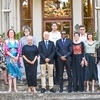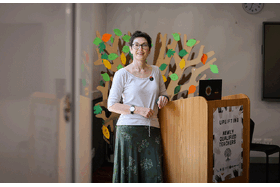Women researchers take centre stage at Soapbox Science 2025
18 November 2025 | Story Stephen Langtry. Photos Nasief Manie. Read time 6 min.
On Saturday, 15 November, the V&A Waterfront’s Clocktower precinct transformed into a vibrant, open-air laboratory as women scientists from across the Western Cape stepped onto literal soapboxes to share their research with the public.
The annual Soapbox Science event demonstrated the power of accessible, informal science engagement; and the sheer curiosity that emerges when cutting-edge research meets passers-by.
Coordinated by the University of Cape Town (UCT) in partnership with regional institutions, Soapbox Science is built on a simple but effective premise: remove the traditional barriers between researchers and non-scientists. No lecture halls, no slides, no microphones – just researchers, the public, and the lively surroundings of one of Cape Town’s busiest public spaces. As shoppers, tourists, and families wandered past, many stopped to listen, ask questions, and join the discussions.
Science in every corner of the clocktower
The event unfolded across three one-hour sessions, each featuring four speakers presenting simultaneously in different corners of the space. This decentralised setup allowed audiences to drift between topics according to their interests: from astronomy to marine ecology, from the role of cows in recycling to the hidden functions of hormones.
“I really loved that we were taking science to the people rather than expecting people to come to us.”
The first session at 14:00 brought to the fore four researchers whose work spans galaxies, cows, microbes, and human health. Among them was Munira Hoosain, a PhD candidate at UCT, whose presentation, “Tuning in to the Universe – how hydrogen gas creates stars”, drew curious onlookers eager to understand how galaxies form. Her research forms part of the LADUMA (Looking At the Distant Universe with the MeerKAT Array) survey, which uses South Africa’s MeerKAT radio telescope to detect the faint signature of hydrogen gas, the essential ingredient for star formation.
Presenting this kind of complexity in a public, informal space, she admitted, was not without its challenges. “Battling the wind and not having the typical structure of a talk with slides made it much more difficult to keep the information (and interest) flowing and engaging,” she reflected. But she was quick to emphasise the special value of being outdoors: “Science is about understanding the natural world and being outside … was a great way to connect the dots. For example, I could talk about the sun and actually point to the sun.”
Around her, the energy was equally lively. Stellenbosch University’s Lobke Steyn explored the role of cows as remarkable natural recyclers, while Nicola Plastow discussed the surprising power of small organisms in improving human well-being. UCT’s Natalie Dicks rounded out the hour with a talk on the hidden power of hormones.
The 15:00 session widened the scientific net further, including shark and ray genetics, CO₂-to-fuel innovation, and the biological enigmas of testosterone and tuberculosis. By 16:00, the focus shifted again: dolphin acoustics, ageing in men, and plant-based skin health all had their turn in the spotlight. Each topic, whether familiar or entirely foreign to listeners, underscored a central message of the event – that science is diverse, evolving, and inherently relevant to society.
Conversations that spark discovery
One of Soapbox Science’s most distinctive features is the ease with which members of the public can approach speakers directly, even interrupting mid-presentation to ask questions or share observations. For Hoosain, this accessibility reshaped her own thinking about science communication.
“Astronomy is a very abstract science,” she explained. “This event highlighted how crucial it is to make my science relevant, by highlighting the impact that it has had on South Africa; and relatable, by tying it to concepts people are curious about, like where the stars we see in the night sky come from.”
Several moments stood out for her, but one interaction was especially memorable. Before the event began, she was approached by a South African Radio Astronomy Observatory (SARAO) photographer who recognised the model of a MeerKAT dish she was carrying, sparking an impromptu conversation about how radio telescopes gather data.
Taking science to the people
Hoosain places a strong emphasis on accessibility in her outreach work, and Soapbox Science aligned deeply with those values. “I really loved that we were taking science to the people rather than expecting people to come to us,” she said. Many typical public lectures require audiences to commit time, travel, and prior interest. Soapbox Science flips this model: science emerges in spaces where people already are.
The diversity of speakers was another highlight. With women researchers from multiple universities and scientific disciplines, the event offered young attendees and families a variety of role models. “This greatly increases the accessibility of science. Soapbox Science featured an incredibly diverse line-up of speakers, which helps young people see themselves as potential scientists as well,” Hoosain said. Looking ahead, she expressed hope for future versions of the event held in communities outside the city centre, such as on the Cape Flats, and potentially in multiple South African languages.
South Africa’s investment in astronomy, through major infrastructures like the Southern African Large Telescope (SALT) and the Square Kilometre Array (SKA), has positioned the country as a global leader in the field. However, as Hoosain emphasised, public engagement remains essential.
Scientific research is largely publicly funded, yet much of it remains obscure to everyday citizens. “Public engagement events allow us to share this public good with the public that fundamentally pays for it,” she noted. For her, the country’s advances in astronomy are inseparable from the outreach initiatives that have inspired young South Africans, including herself, to pursue scientific careers.
“If we want South Africa to continue to advance in science,” she added, “we need events like this that bring science to the people rather than keeping science locked up in the academic ivory tower.”
 This work is licensed under a Creative Commons Attribution-NoDerivatives 4.0 International License.
This work is licensed under a Creative Commons Attribution-NoDerivatives 4.0 International License.
Please view the republishing articles page for more information.




















